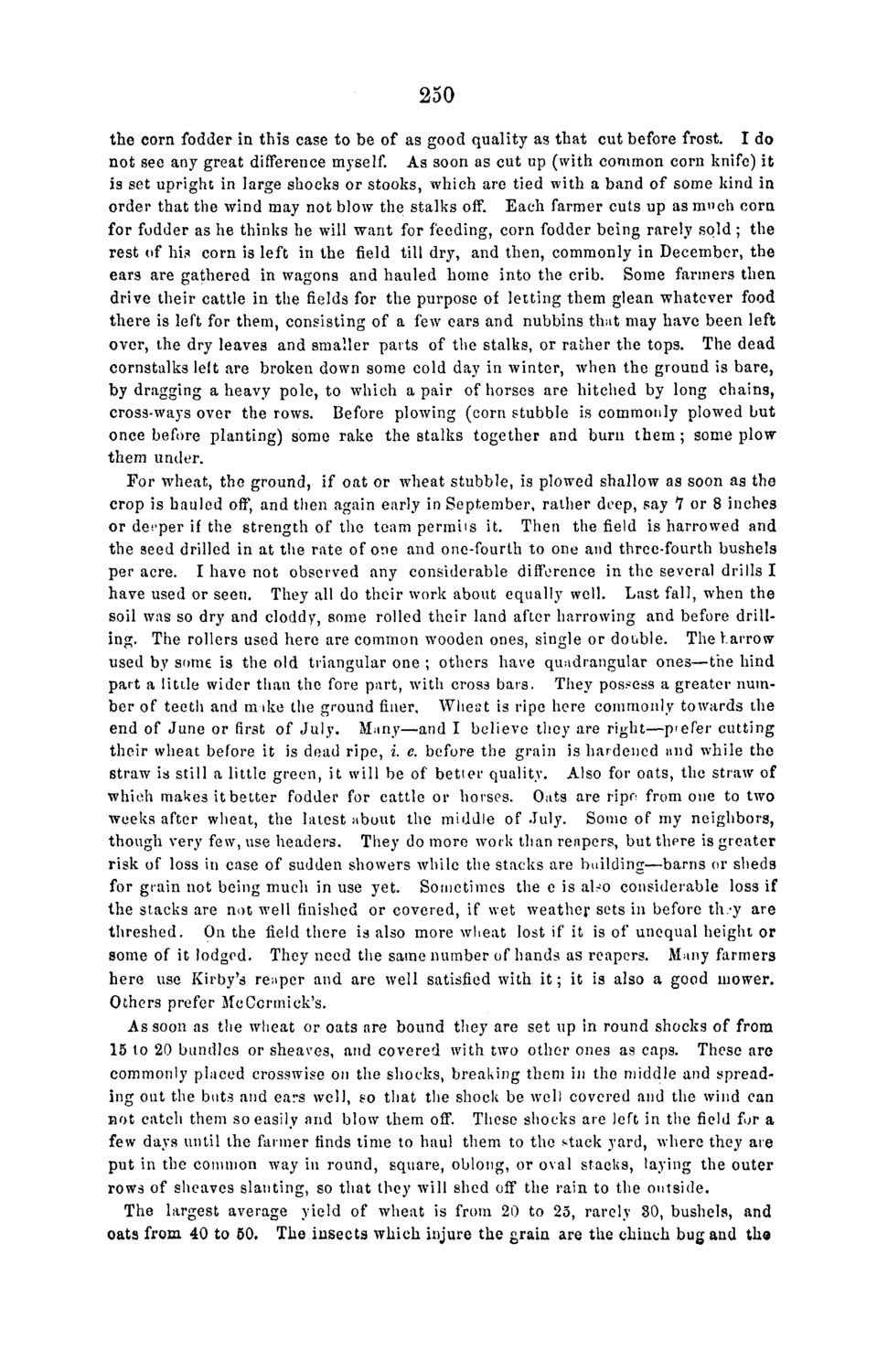| |
| |
Caption: Board of Trustees Minutes - 1868
This is a reduced-resolution page image for fast online browsing.

EXTRACTED TEXT FROM PAGE:
250 the corn fodder in this case to be of as good quality as that cut before frost. I do not see any great difference myself. As soon as cut up (with common corn knife) it is set upright in large shocks or stooks, which are tied with a band of some kind in order that the wind may not blow the stalks off. Each farmer cuts up as much corn for fodder as he thinks he will want for feeding, corn fodder being rarely sold ; the rest of his corn is left in the field till dry, and then, commonly in December, the ears are gathered in wagons and hauled home into the crib. Some farmers then drive their cattle in the fields for the purpose of letting them glean whatever food there is left for them, consisting of a few ears and nubbins that may have been left over, the dry leaves and smaller parts of the stalks, or rather the tops. The dead cornstalks left are broken down some cold day in winter, when the ground is bare, by dragging a heavy pole, to which a pair of horses are hitched by long chains, cross-ways over the rows. Before plowing (corn stubble is commonly plowed but once before planting) some rake the stalks together and burn t h e m ; some plow them under. For wheat, the ground, if oat or wheat stubble, is plowed shallow as soon as the crop is hauled off, and then again early in September, rather deep, say 7 or 8 inches or deeper if the strength of the team permiis it. Then the field is harrowed and the seed drilled in at the rate of one and one-fourth to one and three-fourth bushels per acre. I have not observed any considerable difference in the several drills I have used or seen. They all do their work about equally well. Last fall, when the soil was so dry and cloddy, some rolled their land after harrowing and before drilling. The rollers used here are common wooden ones, single or double. The harrow used by some is the old triangular one ; others have quadrangular ones—the hind part a little wider than the fore part, with cross bars. They possess a greater number of teeth and m ike the ground finer. Wheat is ripe here commonly towards the end of June or first of July. Many—and I believe they are right—piefer cutting their wheat before it is dead ripe, i. e. before the grain is hardened and while the straw is still a little green, it will be of better quality. Also for oats, the straw of which makes it better fodder for cattle or horses. Oats are ripo from one to two weeks after wheat, the latest about the middle of July. Some of my neighbors, though very few, use headers. They do more work than reapers, but there is greater risk of loss in case of sudden showers while the stacks are building—barns or sheds for grain not being much in use yet. Sometimes the e is al.-o considerable loss if the stacks are not well finished or covered, if wet weather sets in before th.*y are threshed. On the field there is also more wheat lost if it is of unequal height or some of it lodged. They need the same number of hands as reapers. Many farmers here use Kirby's reaper and are well satisfied with i t ; it is also a good mower. Others prefer McCcrmick's. As soon as the wheat or oats are bound they are set up in round shocks of from 15 to 20 bundles or sheaves, and covered with two other ones as caps. These are commonly placed crosswise on the shocks, breaking them in the middle and spreading out the buts and ears well, so that the shock be well covered and the wind can not catch them so easily and blow them off. These shocks are left in the field for a few days until the farmer finds time to haul them to the *tack yard, where they are put in the common way in round, square, oblong, or oval stacks, laying the outer rows of sheaves slanting, so that they will shed off the rain to the outside. The largest average yield of wheat is from 20 to 25, rarely 80, bushels, and oats from 40 to 50. The insects which injure the grain are the chinch bug and the
| |